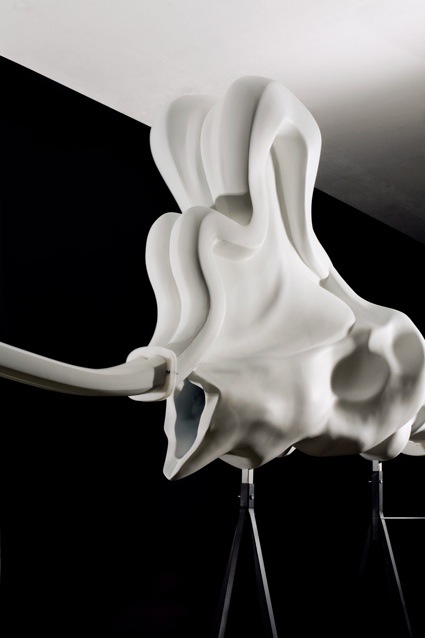 Mammoth Imperator, -4,5M years ago, Installation view – Photo credit: Stuart Bailes
Mammoth Imperator, -4,5M years ago, Installation view – Photo credit: Stuart Bailes
More than 2 years ago, i was interviewing young designer Marguerite Humeau about her attempt to bring back to life the voice of extinct creatures by reconstructing their voice box. The idea is even bolder than it sounds because the lungs, trachea, larynx + vocal folds, mouth and nose are made of soft tissue, and therefore don’t fossilize. Marguerite started by giving her voice back to Lucy (aka Australopithecus Afarensis), one of the first hominids who used to live 3,85 to 2,95 million years ago.
Since then, Marguerite’s work has gathered awards, been presented in several exhibitions and discussed in conferences. But even more interestingly, the resuscitation endeavour has expanded to more extinct animals. A mammoth and two ultra ugly and fearsome creatures, the Walking Whale and the Terminator Pig, have now joined the loud party.
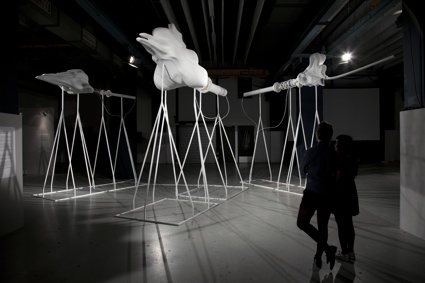 The Opera of Prehistoric Creatures. Left to right: Entelodont, “Hell Pig”, -25M years ago; Ambulocetus, “Walking Whale”, -50M years ago; Mammoth Imperator, -4,5M years ago. Photo credit: Dirk van den Heuvel, March 2013
The Opera of Prehistoric Creatures. Left to right: Entelodont, “Hell Pig”, -25M years ago; Ambulocetus, “Walking Whale”, -50M years ago; Mammoth Imperator, -4,5M years ago. Photo credit: Dirk van den Heuvel, March 2013
To re-create the vocal tract of the animals, the designer met with paleontologists, elephant vocalization specialists, explorers, engineers and other experts. The process of reconstruction involved shaping 3D models of the soft tissue from MRI scans and/or fossil data. Sending air through the resulting prototypes triggers a sound that might be similar to the sound the prehistoric creatures made when they were alive.
Marguerite presented the animals in the Politique-Fiction exhibition in Saint-Etienne. Check out the audio recording. More recently, the prehistoric creatures where in Eindhoven for the STRP biennial where they performed live for the first time together with Dutch musician and DJ Jameszoo. If you’re curious about the result of the encounter, just click on the images at the bottom of this page.
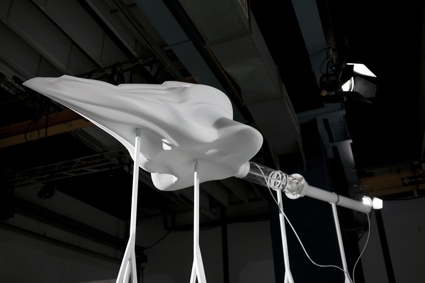 Entelodont, “Hell Pig”, -25M years ago – Photo credit: Dirk van den Heuvel – March 2013
Entelodont, “Hell Pig”, -25M years ago – Photo credit: Dirk van den Heuvel – March 2013
Sadly, i missed the prehistoric creatures’ performance in Eindhoven. Which gave me a good excuse to contact Marguerite and get more details about her work:
Hi Marguerite! I first interviewed you during the work in progress show at RCA. You were starting to work on ‘bringing back to life’ the vocal chords of Lucy (Australopithecus Afarensis) who used to live 3,85 to 2,95 million years ago. Your new opera features 3 prehistoric creatures. An Ambulocetus, an Entelodont, and a Mammoth. Can you tell us why you chose these 3 creatures? And what they are exactly?
We talked at the very beginning of my epic quest to resuscitate the sound of prehistoric creatures by reconstructing their vocal tracts.
‘The opera of prehistoric creatures’ now features three beasts namely an Ambulocetus aka ‘Walking Whale’ (which used to live 50 to 48 million years ago), an Entelodont aka ‘Terminator Pig’ (which used to live 38 to 16 million years ago), and a Mammoth Imperator (which used to live 4,5 million years ago). All three pieces are realised on a 1/1 scale and standing on trestles at the height of each original animal.
I first started to work on Lucy, one of the first hominid. Lucy is now part of the MoMA permanent collection and touring as part of a show curated by Mark Leckey for the Hayward Gallery (Hayward Touring program) called The Universal Addressability of Dumb Things. The show deals with our contemporary animistic relationship to the objects around us. As Mark Leckey explains, “as modern technology becomes more pervasive objects appear to communicate with us”. This seems to bring us back “an archaic state of being, to aboriginal landscapes of fabulous hybrid creatures, where images are endowed with divine powers, and even rocks and trees have names”.
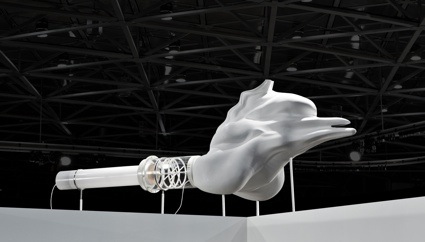 Ambulocetus, “Walking Whale”, -50M years ago, Installation view – Photo credit: Felipe Ribon
Ambulocetus, “Walking Whale”, -50M years ago, Installation view – Photo credit: Felipe Ribon
The three large pieces – Entelodont, Ambulocetus, and Mammoth Imperator – are hypothetical reconstructions of the beasts vocal tracts. Because the vocal tract (larynx, vocal chords, trachea, lungs, resonance cavities) is made of soft tissue, it does not fossilise. This was problematic from a scientific perspective. But as a designer, solving this enigma was really exciting. I would have to redesign all these inner parts, using different areas of science, but also, and most important, other tools like speculation, design, rumours, collective imaginary.
My work of reenactment was therefore made difficult. The project questions the way we talk about prehistory – and about our history. How can we talk about something that has entirely disappeared? All the attempts to tell this story will only be one version amongst many different versions of the original story.
This was made very clear in the process of the project. We have a lot of clues on how Woolly Mammoth used to look like, to sound like, where they used to live, etc. Also, as we talked about last time, there are a few Woolly Mammoths which have been found in the Siberian permafrost. We have much less clues on how the Mammoth Imperator used to be like. This is why I was really interested in it.
The plot thickens with the Walking Whale, a terrestrial mammal which started to swim. I speculated on its vocal tract. It might have been somewhere between a larynx (like terrestrial mammals) and a sonar (like dolphins).
Ambulocetus, from the BBC series Walking with Beasts
There are equally very few fossils of the Terminator Pig. I therefore even had to recreate a fictional skull of this creature so I could base my research on something tangible.
The beasts are now revived. They are semi-real, synthetic ruins.
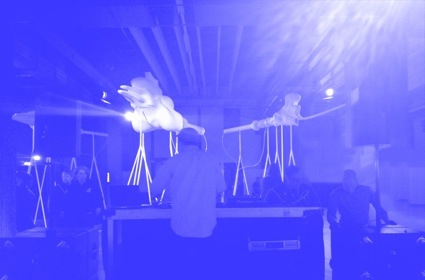 Setting-up the performance
Setting-up the performance
The 3 beasts are performing in an opera which premiered at the STRP biennial a few weeks ago. I couldn’t be there for the performance but i did see the beasts in the exhibition. How did you animate them? What was the performance like?
The beasts perform an opera. Each of them produces a sound as their vocal chords vibrate. The sound is controlled by a ‘brain’ which was designed by Julien Bloit. We had long conversations together with Julien Bloit and our sound collaborator Charles Goyard on how this brain should be constructed. We looked into Claude Levi-Strauss research and were especially inspired by this quote: «Humanity is constantly struggling with two contradictory processes. One of these tends to promote unification, while the other aims at maintaining or re-establishing diversification».
We were interested in the idea of creating a fictitious cycle for a speculated rebirth. We also looked into Oudeyer‘s research on the evolution of speech.
Instead of starting from a parent (single) call, and then get more and more complex like most languages; we would reverse the process so the beasts would get born as complex beings and tend towards simplification and unification.
Each performance lasts for 1H30.
For STRP we tried a new experiment. We asked local dubstep musician Mitchel van Dinther (aka Jameszoo) to tell the beasts a story in 3 acts. For the performance, I asked Mitchel to face the beasts, so it was a battle between himself (the maestro) and the three creatures. As if he was persuading them to reveal something. Mitchel was challenging them to react to the story, trying to find the right notes and attempting to have an impossible conversation.
PERFORMANCE
Synopsis
No reenactment is possible without destroying the original versions of the extinct and unknown creatures that we are trying to resuscitate. We soon realised that, in the absence of evidentiary material, we would have to pillage past and present times. We don’t copy, and we don’t remix, but what we do is recreate. We clone beasts and we clone beats. The soundtrack is dark and exhilarating, creating an electronic ceremony for semi-real animals. We are the tour guides of this post-prehistoric jungle.
Act I – Extinction – 3″
This act shows the creatures’ last days and their fight against extinction. The last descendants of each of these species have disappeared and the circumstances of their extinction remain unknown. This first act is a reenactment of the process of extinction which took place millions of years ago.
Act II – Prehistoric cryogenics – 7″
Millions of years later surprising discoveries are made around the Taymyr Peninsula in Siberia. In 2007 the body of a 37,000 year old baby mammoth is found frozen and perfectly preserved. This baby mammoth, Lyuba, is now the oldest baby on Earth. The sleeping beauty has now awoken and its genes will be used to clone a synthetic woolly mammoth. Similar processes will be used to clone a ‘terminator pig’ and a ‘walking whale’. This act also relays the story of a modern Professor, Frankenstein, whose ambition is to grow prehistoric vocal cords. At the end of this act the beasts are brought back to life and the first semi-real roars can be heard.
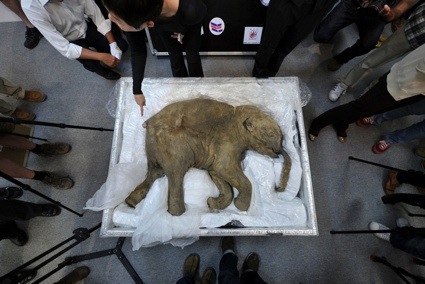 The carcass of the world’s most well-preserved baby mammoth, named Lyuba, is displayed in Hong Kong on April 10, 2012. Photo credit: Aaron Tam / AFP – Getty Images
The carcass of the world’s most well-preserved baby mammoth, named Lyuba, is displayed in Hong Kong on April 10, 2012. Photo credit: Aaron Tam / AFP – Getty Images
Act III – Reverse evolution – 4″
The beasts are semi-real and suddenly they roar in a non-macabre but spectacular pandemonium. The beasts are alive, but while their voices and their linguistic skills evolve they face complex challenges. Claude Levi-Strauss wrote that humanity was constantly facing two contradictory processes; the beasts are struggling with similar evolutionary contradictions. While one process promotes unification, the beasts will also try to maintain and reaffirm diversification. It is not known whether the beasts will embrace a unique, primal sound or if they will succeed in their quest to become complex and ever-evolving creatures.
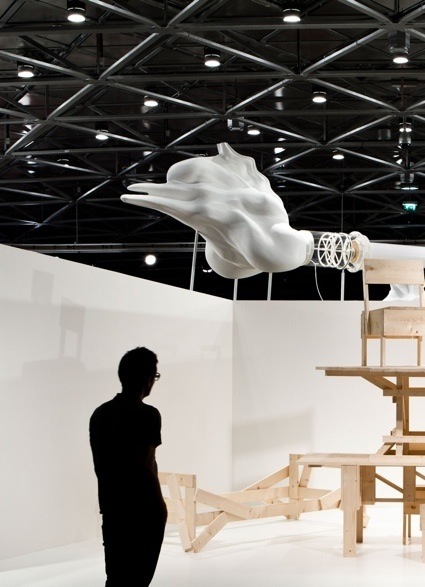 Walking Whale in Politique Fiction exhibition curated by Alexandra Midal, installation view. Image credit: Felipe Ribon
Walking Whale in Politique Fiction exhibition curated by Alexandra Midal, installation view. Image credit: Felipe Ribon
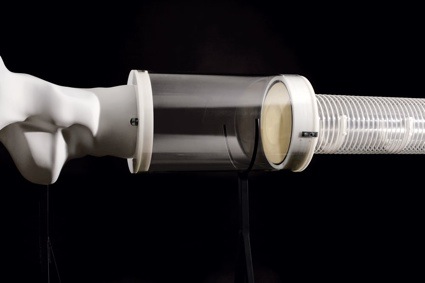 Mammoth Imperator. Larynx with vocal cords, 2012
Mammoth Imperator. Larynx with vocal cords, 2012
A text describing the opera says that the performance “sets up the rebirth of three cloned prehistoric creatures, showing their wanderings and their epic journey through time. They are seeking to evolve in our contemporary era.” How do you see them evolving in our era? Surely, there is no place for them now?
The opera is an ambiguous piece of work. On one hand, the revived creatures and their sounds are fascinating and exhilarating. On the other hand, one might think: “How far will we go with cloning technologies? Is this really what we want?”.
Proposal for Resuscitating Prehistoric Creatures- Installation trailer (Video: Ben Penna, Sound: Association Phonotonic)
Are you planning to do something else with these creatures? Or are they happy staring in an opera only?
“Proposal for Resuscitating Prehistoric Creatures” is now comprised of a trailer directed by Benjamin Penaguin; a book called “The Infinite Odyssey” gathering all my documents and correspondence; an ‘Épopée’ in 14 chapters which has been published in TAR Magazine Issue n.9.
There is the large-scale installation with the three creatures, and Lucy … Then the performance with Mitchel van Dinther accompanied by a libretto.
I am very interested in the idea of an infinite, never-ending project, a project that always renews itself and comes back to life in different forms.
This project is the first chapter of the ‘design trilogy’ I am currently working on, which deals with attempting to communicate with unreachable, extinct or unknown forms of life.
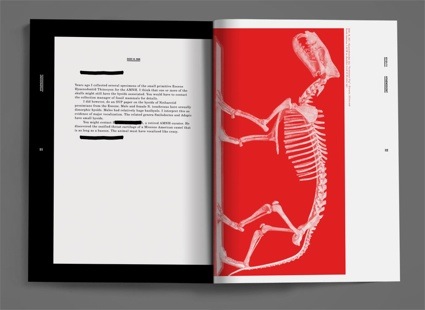 The Infinite Odyssey – correspondance et documents — 38 X 26.5 CM – Edition of 10- Collection: MoMA, New York, 2011
The Infinite Odyssey – correspondance et documents — 38 X 26.5 CM – Edition of 10- Collection: MoMA, New York, 2011
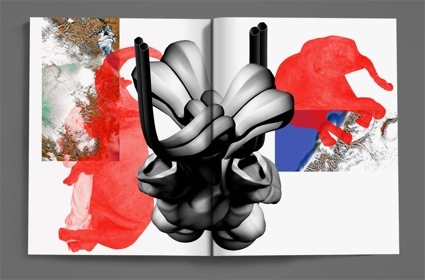
Tar Magazine
“Epopée” written and designed by Marguerite Humeau with extracts from book designed by Ghazaal Vojdani – 32.5 X 35 CM – April 2013
I’m also intrigued by the people you collaborated with in order to create the opera. Namely, Jameszoo, Julien Bloit and Ben Penna. How did you get to work with them? Is it easy to convince other artists to work on an opera for prehistoric creatures?
In June 2011, I completed the Mammoth Imperator for my final show at the Royal College of Art. I was then commissioned by curator Alexandra Midal to complete my opera for the exhibition Politique-Fiction at the Cité du design in Saint-Etienne.
I started then to work with Julien Bloit who is a research engineer and musician; and engineer/inventor Charles Goyard whom I worked with to refine the design of the larynges and vocal cords. Working together was truly fantastic. We would spend days experimenting in Charles’ studio in Montreuil, discussing about the project on a more conceptual level, building and testing prototypes.
The project is like a science-fiction adventure film made for real. I was also interested in using strategies from the film industry to exhibit the project, as an installation, online, as a printed story, and so on.
I have been discussing about this project from the very beginning with art director/graphic designer Benjamin Penaguin . We then developed the idea of a trailer together and I gave him “Carte blanche”. We now work and discuss a lot together. Benjamin also designed the libretto for the performance Beasts Back Saga with Mitchel van Dinther.
I discovered Mitchel’s music recently. I immediately became a big fan of his EP Faaveelaa. He mixes the sound of his chicken (which lives in his kitchen) and of his parrot to create very strange and interesting beats. I wrote a story in three acts and asked him to create a track for each chapter. It was also a “Carte Blanche”.
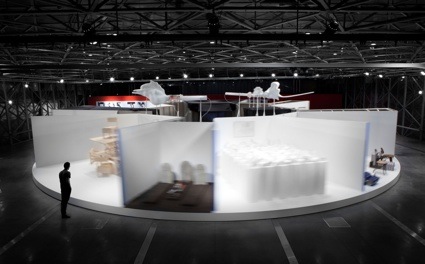 The Opera of Prehistoric Creatures. Installation view
in Politique Fiction exhibition
. Curator: Alexandra Midal. Image credit: Felipe Ribon
The Opera of Prehistoric Creatures. Installation view
in Politique Fiction exhibition
. Curator: Alexandra Midal. Image credit: Felipe Ribon
Any upcoming project, field of investigation, or exhibition you’d like to share with us? Do you want to talk about the letters to the (almost) Aliens?
I am working on the second chapter of my design trilogy for my upcoming solo show.
With ‘The Opera of Prehistoric Creatures’ project, I wanted to explore the use of design as a catalyst of supernatural events and miracles, as a producer of real-time science-fictions and as the prosthetics of parallel worlds. These are topics I have been investigating since my Master dissertation at the Royal College of Art.
In this second chapter I will explore the idea of the ‘designer-illusionist’ further.
This new project is an epistolary novel relating my attempt to communicate with the possible ‘almost-alien’ inhabitants of the Vostok Lake in Antarctica.
The Vostok Lake is one lake amongst four hundreds subglacial lakes in Antarctica which are covered with kilometres of ice. The Vostok lake has been isolated under three kilometers of ice from the rest of the world for more than fifteen million years.
A dilemma emerges from this situation. Drilling through the ice and reaching the lake (like what the Russian scientific team has been doing in the past years) means altering its ‘alien’ character. But if we choose not to enter this lake we are left with a complete mystery.
This situation also occurs in Fellini’s film Roma. While building the Roman subway, the workers reach a wall. They have to drill through this wall in order to pursue the construction of the subway. They discover behind this wall a magnificent roman villa covered with beautiful frescoes. These paintings had been isolated from the rest of the world for thousand of years.
The hole is drilled. Immediately, the paintings start vanishing. Exposing them to modern air triggers their instant destruction.
Fellini, Roma, 1972
How could I find an alternative way to communicate with these ‘almost-aliens’ without penetrating the lake pristine waters? And how could I convince them to reveal their identity and tell us more about what is hidden under the ice? How could my “letters” to them look like?
Maybe I could trick them into thinking that we know who they are… using illusions, mimicry, or camouflage, building dummies in order to trigger a response.
I am really inspired by the work of illusionist Jasper Maskelyne who was hired by the British Army during the Second World War. He and his “Magic Gang” used magic tricks on a large-scale: they made Alexandria disappear, created a dummy army with fake tanks and soldiers and so on.
This project could also refer to Ettore Sottsass “Ceramics of Darkness” designed in 1963.
I am currently being advised by glaciologists, illusionists, psychologists, conspiracy theorists, telepathy practitioners and even dowsers.
The piece will be unveiled in a solo exhibition curated by Alexandra Midal in the Design Project Room, at the HEAD in Geneva in November 2013.
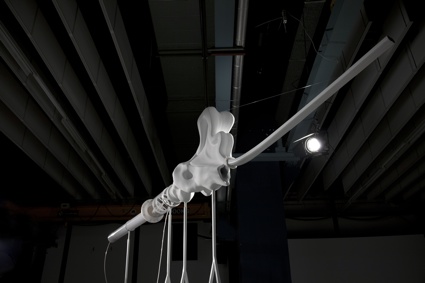 Mammoth Imperator, -4,5M years ago, Installation view. Photo credit: Dirk van den Heuvel, March 2013
Mammoth Imperator, -4,5M years ago, Installation view. Photo credit: Dirk van den Heuvel, March 2013
Merci Marguerite!
The Universal Addressability of Dumb Things curated by Mark Leckey is at Nottingham Contemporary until 20 Oct 2013. I think i might go….
Previously: The rebirth of prehistoric creatures and STRP Biennial, a walk through the city of cyborgs.
